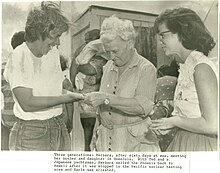Barbara Leonard Reynolds
In 1965, she established the World Friendship Center in Hiroshima, Japan in order to introduce international visitor to atomic bombing sufferers (hibakusha) so that they could fully convey their experience of nuclear war to the global community.
In 1975, Reynolds established the Peace Resource Center at Wilmington College to spread awareness of the nuclear threat and the experiences of hibakusha to the American public.
After this, she continued her peace and anti-nuclear activism, and after 1978, in California, she helped to resettle Cambodians fleeing Pol Pot, among other humanitarian pursuits.
Barbara's paternal grandmother, Eva Leonard, was a syndicated daily columnist in over 200 newspapers during World War II and later wrote advice to the lovelorn under the name Elizabeth Thompson.
[5] Barbara was fifteen years old — and one month from graduating from high school — when her father, 43, a popular English teacher at the University of Wisconsin, drowned in Lake Mendota.
In 1958, the family (minus their eldest son Tim) and a crew member, Niichi (Nick) Mikami, arrived back in Honolulu.
[9] On July 2, 1958, the Reynolds family and Nick sailed the Phoenix into the test zone and were stopped 65 miles (105 km) by the American Coast Guard ship Planetree.
He was ordered to sail the Phoenix to Kwajalein, from which he, Barbara and Jessica were flown back to Honolulu by MATS plane for Earle's trial.
After Reynolds' conviction and its reversal after a two-year appeal, the family completed their circumnavigation, which made Mikami the first Japanese yachtsman to sail around the world.
On arriving in Hiroshima to an enthusiastic welcome, the Reynolds family were surprised at the appreciation expressed by hibakusha (literally, explosion-affected people), the atomic bomb survivors, for their protest against nuclear weapons.
Over five months, the three Peace Pilgrims traveled through 13 countries, including the Soviet Union, appealing for nuclear disarmament and receiving a warm and open reception from public leaders, churches, schools and the media.
Two years later Barbara organized the World Peace Study Mission, taking 25 survivors of both cities plus 15 interpreters to every nuclear nation, including the USSR.
Dr. Tomin Harada, a physician who dedicated his life to the continuing medical needs of the hibakusha due to delayed radiation sickness, and who had named a species of rose he developed after Barbara, wrote in one of his two books about her, "Through Barbara's World Peace Study Mission the survivors of the atomic bomb were introduced to the world and the anti-nuclear movement gained strength.
Barbara developed "Hibakusha Handicrafts," finding people to teach them to make simple coin purses and other things which she would bring to the States to sell for them.
In August 1975, Barbara found a home for the 3,000 books and documents she had gathered regarding Hiroshima, Nagasaki, nuclear weapons and peace in both Japanese and English.
During this time she was working to persuade senators to let a badly-wounded young Vietnamese woman, Mai Phuong Dao, out of Ho Chi Minh City.
After the family had sailed around the world in a yacht designed and built by her husband, Barbara switched back to adult non-fiction to co-author All in the Same Boat with him.
For her contributions to the welfare of survivors, including the founding of the World Friendship Center, Barbara was presented with a key to the city of Hiroshima in 1969 and in 1975 was made an honorary citizen by Mayor Araki, the first woman so honored and only the second American, the first being Norman Cousins for raising the funds to bring 25 "Hiroshima Maidens"[16] to the States for surgery for their severe injuries from the atomic bomb.
[17] Fifteen women, all over 40, were chosen for trying to right wrongs "people don't want to talk about," according to Koryne Horbal, Executive Director of the Wonder Woman Foundation, a non-profit organization founded in 1981.





